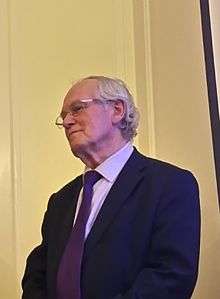John Burland
| John Burland | |
|---|---|
 John Burland in Cambridge, 2016 | |
| Born | 4 March 1936 |
| Alma mater |
Witwatersrand University University of Cambridge |
| Thesis | Deformation of soft clay (1967) |
| Doctoral advisor | Kenneth H. Roscoe |
John Boscawen Burland CBE FREng[1] FRS (born 4 March 1936) is an Emeritus Professor and Senior Research Investigator at the Department of Civil and Environmental Engineering of Imperial College London.[2]
Early education
John Burland attended Parktown Boys' High School and then received a First Class Honours BSc degree in Civil Engineering from Witwatersrand University in 1959. Then he moved to the University of Cambridge where he carried out research in Soil Mechanics under the supervision of Professor Kenneth H. Roscoe which led to the award of a PhD degree in 1967. His thesis title was Deformation of soft clay. He then moved to Imperial College London where he served as Professor of Soil Mechanics for over 20 years and Head of the Geotechnics Section.
Achievements
Burland is best known as the engineer who prevented the Leaning Tower of Pisa from toppling over,[3][4][5][6] He was awarded the Knight Commander of the Royal Order of Francis I by the Duke of Castro. He was also involved in ensuring that the Houses of Parliament and Big Ben were unharmed by the extension of the London Underground Jubilee line.
Burland worked also on the construction of a large underground park at the Palace of Westminster and the stabilising of the Metropolitan Cathedral of Mexico City. His team was also involved in the extension of the Jubilee line and he has advised on many geotechnical aspects of that project, including ensuring the stability of the Big Ben Clock Tower.
He is very well known for his work on Critical state soil mechanics and the development of the Modified Cam Clay constitutive model for reconstituted clays.[7]
Awards
His contribution to Soil Mechanics has been greatly acknowledged and he was invited to deliver the 30th Rankine Lecture of the British Geotechnical Association titled On the compressibility and shear strength of natural clays.[8] Moreover, he was awarded the Institution of Structural Engineers Gold Medal in 1997. In 2002 he presented the Higginson Lecture[9] and the Victor de Mello Lecture.[10] He was appointed as a Fellow[11] of the Royal Academy of Engineering[12]
Burland also received an Honorary Doctorate from Heriot-Watt University in 1994 [13]
References
- ↑ "List of Fellows".
- ↑ Burland, John B.; Mair, Robert James (2013). "Sir Alan Marshall Muir Wood FREng FICE. 8 August 1921 -- 1 February 2009". Biographical Memoirs of Fellows of the Royal Society. doi:10.1098/rsbm.2013.0011.
- ↑ Burland, J. B.; Jamiolkowski, M.; Viggiani, C. (1998). "Stabilising the leaning tower of Pisa". Bulletin of Engineering Geology and the Environment. 57: 91. doi:10.1007/s100640050025.
- ↑ Morley, Jane (December 9, 1998). "Tilting the Tower of Pisa". The Washington Post. Retrieved November 7, 2016.
- ↑ Radford, Tim (8 September 2000). "Tube lesson helps save Pisa's tower". The Guardian. Retrieved 7 November 2016.
- ↑ Smart, Alastair (28 July 2010). "Solving the 800-year mystery of Pisa's Leaning Tower". The Telegraph. Retrieved 7 November 2016.
- ↑ Graham, J.; Tanaka, N.; Crilly, T.; Alfaro, M. (2001). "Modified Cam-Clay modelling of temperature effects in clays". Canadian Geotechnical Journal. 38 (3): 608. doi:10.1139/cgj-38-3-608.
- ↑ Burland, J. B. (1990). "On the compressibility and shear strength of natural clays". Géotechnique. 40 (3): 329. doi:10.1680/geot.1990.40.3.329.
- ↑ "School of Engineering and Computing Sciences (ECS) : Speakers abridgment - Durham University". Dur.ac.uk. Retrieved 2012-08-26.
- ↑ "1a Palestra Victor de Mello (in Portuguese)". Retrieved 2013-01-21.
- ↑ "List of Fellows".
- ↑ "List of Fellows".
- ↑ [email protected]. "Heriot-Watt University Edinburgh: Honorary Graduates". www1.hw.ac.uk. Retrieved 2016-04-04.